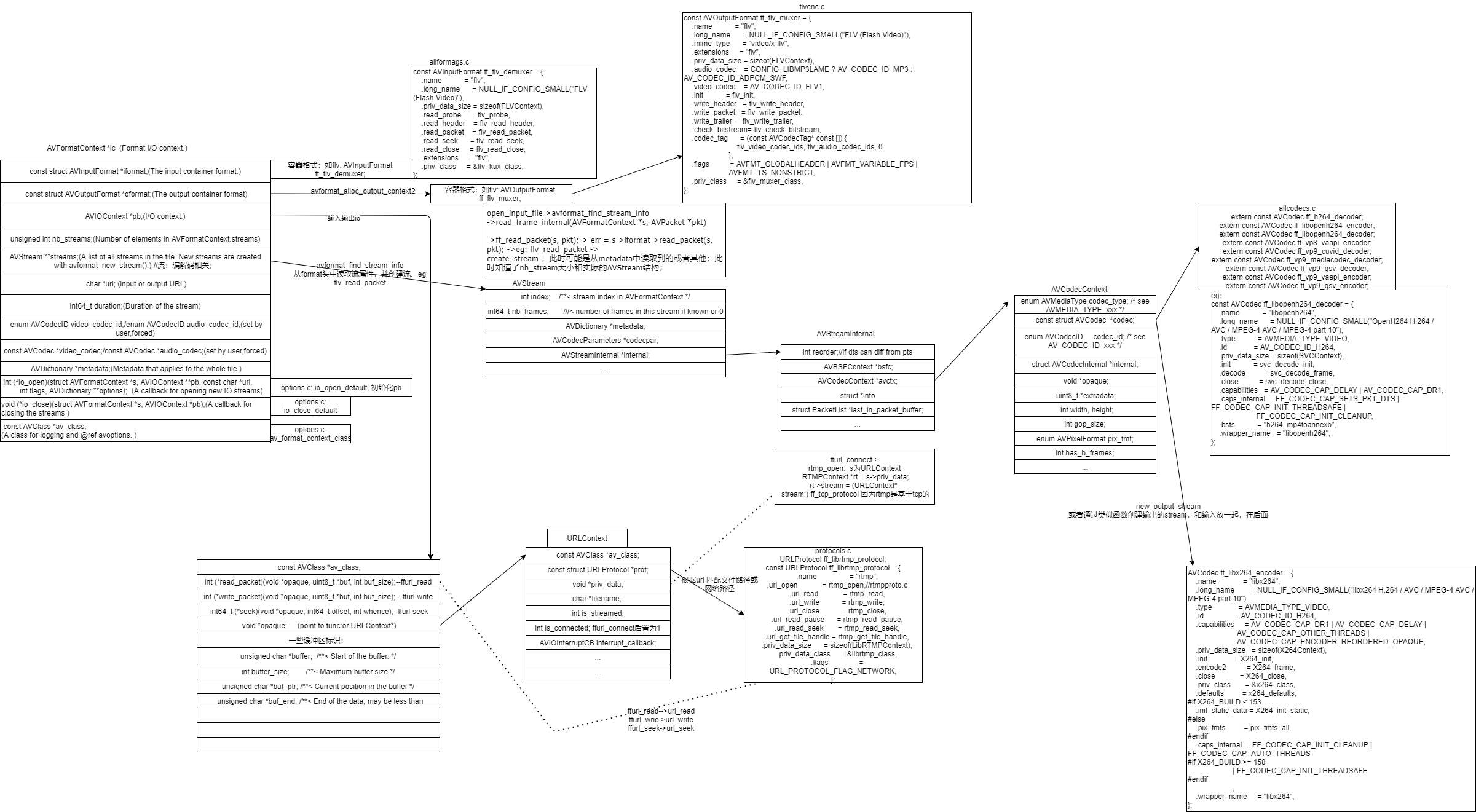ffmpeg 源码简介
ffmpeg源代码中,有很多函数钩子挂载点,类似linux内核,因为ffmpeg也是c语言写得,所以这样实现,有利于接入新类型,即泛型。
也使得代码结构更清晰更容易阅读。
ffmpeg源码结构图

ffmpeg.c分析:
为了了解ffmpeg的框架结构,先看看ffmpeg工具是如何调用ffmpeg中的接口的。
总体:
ffmpeg.c:
1 | int main(int argc, char **argv) |
解析参数,初始化输入输出
ffmpeg_parse_options(argc, argv);//解析输入参数,包括input,output,–关键函数1
分析:
1 | int ffmpeg_parse_options(int argc, char **argv) |
初始化输入文件:
1 | static int open_input_file(OptionsContext *o, const char *filename) |
初始化输出:
1 | //输出: |
分析主循环:
1 | if (transcode() < 0)//读取接收的媒体数据,进行处理: 主循环,也就这个循环了。--关键函数2 |
分析输入url的结构框架构建:
对应结构:AVIOContext *s, 重要数据结构:
以rtmp输入为例:
可以用ffmpeg做推拉流,但是主要是client端,传入的filename携带 “rtmp” 关键字;
从上面的分析可以看到:
open_input_file的时候:会调用:io_open_default
接着去找一个URLProtocol结构的实例,然后挂载,那么具体是什么样的?
ffmpeg在编译后会生成一个:”libavformat/protocol_list.c” 文件,包含一个URLProtocol类型
的数组:
如:
1 | static const URLProtocol * const url_protocols[] = { |
看下ff_rtmp_protocol:如何被定义:rtmpproto.c:
1 | #define RTMP_PROTOCOL_0(flavor) |
跟踪如何找到URLProtocol 实例:
1 | io_open_default-> |
实际运行bt:
1 | 推流到url 或者说输出的场景: |
分析读取文件解析容器格式框架:
对应:avformat_open_input ,对应上面调用init_input下子过程
读取文件内容解析成flv或其他容器格式: AVPacket的过程:
对应结构:AVInputFormat
相关结构:猜测容器格式?通过扩展名。 allformats.c 中罗列了所有的扩展名下的容器格式处理结构;
1 | extern const AVOutputFormat ff_flac_muxer; |
demuxer_list结构,在编译后生成:libavformat/demuxer_list.c:
1 | static const AVInputFormat * const demuxer_list[] = { |
相关逻辑深入:
1 | const AVInputFormat *av_probe_input_format2(const AVProbeData *pd, |
寻找解码器的过程:
对应open_input_file的子过程:avformat_find_stream_info
关键结构:AVCodec
allcodecs.c
1 | extern const AVCodec ff_h264_amf_encoder; |
codec_list数组,libavcodec/codec_list.c
1 | static const AVCodec * const codec_list[] = { |
关键逻辑:
1 | codec = find_probe_decoder(ic, st, st->codecpar->codec_id); |
一些结构解释:
AVStream 是流的结构,一个流一个实例,其中这个结构中有AVStreamInternal ,其中又AVCodecContext,
即含有编码解码相关结构;
一个场景例子:
输入一个url rtmp/其他的网上的流, 转码,转封装后,推流到网上。
1 | -re -i source.flv -c copy -f flv -y rtmp://localhost:1936/live/livestream |
关于封装,更多:
封装和头: mux.c
1 | int avformat_write_header(AVFormatContext *s, AVDictionary **options) |
音频格式中的头怎么封装的? 其实是 AVFormatContext 中的AVFormatContext 成员,
在识别文件名或输入的格式后,去找对应的AVOutputFormat ,预定义的:
如: adtsenc.c:
1 | const AVOutputFormat ff_adts_muxer = { |
更多格式:
allformats.c:
还有类似flac等,都可以在这里查到解封装和封装,主要是头,和编解码无关。
编解码更多:
MPEG2编码器对应的AVCodec结构体ff_mpeg2video_encoder:
1 | init() -> encode_init() |
mpeg12enc.c:
1 | const AVCodec ff_mpeg1video_encoder = { |
more: 见源码和官网